Performance Analysis of ALOHA and S-ALOHA Protocols
VerifiedAdded on 2023/06/03
|14
|2131
|222
AI Summary
This lab experiment involves the simulation and analysis of ALOHA and S-ALOHA protocols used in communication networks. The experiment aims to understand the basic concepts of random-access techniques and principles of ALOHA and S-ALOHA protocols. The performance of these protocols is analyzed under different load conditions. The simulation results indicate that S-ALOHA exhibits higher efficiency and throughput due to the slots present in it, which minimize collision at the receiver end during data transmission.
Contribute Materials
Your contribution can guide someone’s learning journey. Share your
documents today.
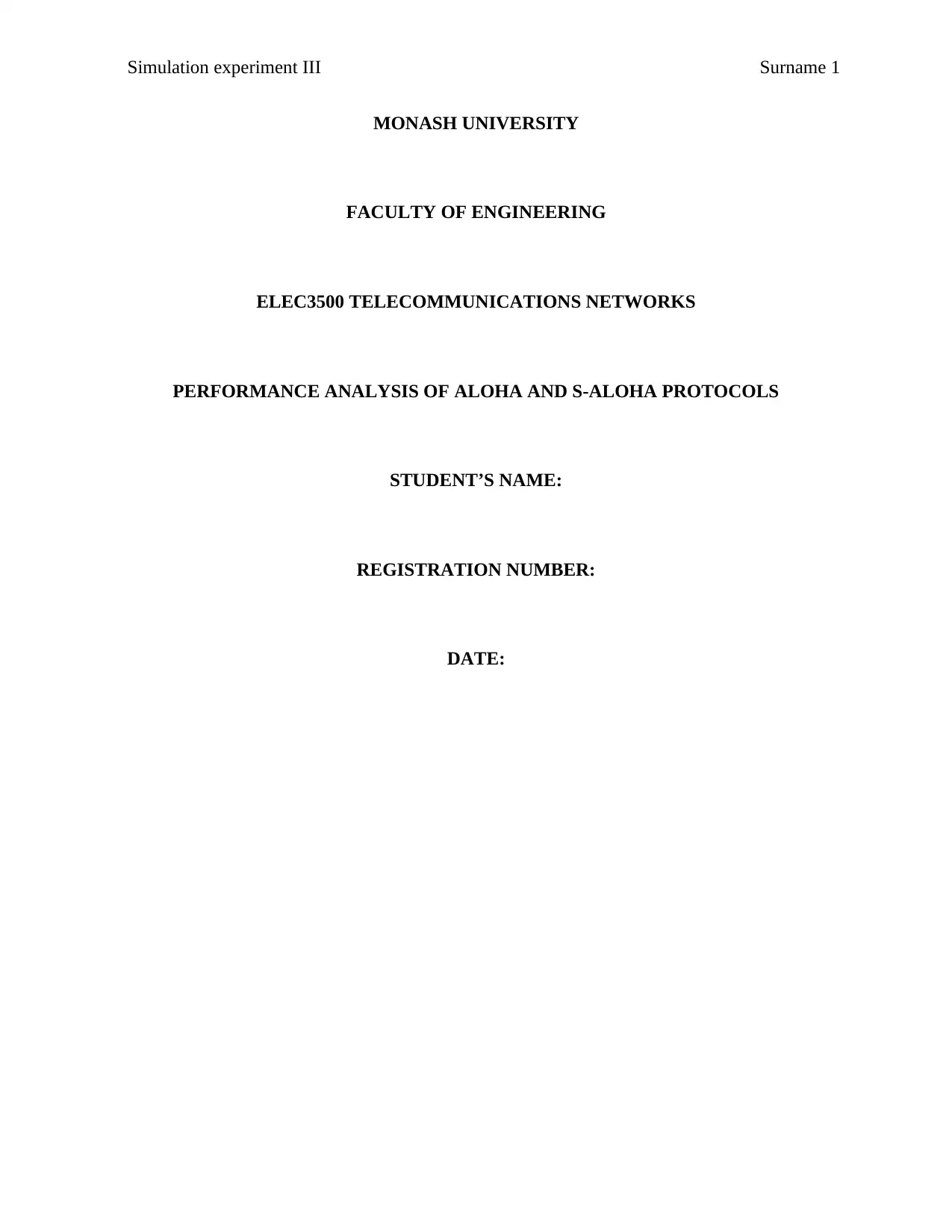
Simulation experiment III Surname 1
MONASH UNIVERSITY
FACULTY OF ENGINEERING
ELEC3500 TELECOMMUNICATIONS NETWORKS
PERFORMANCE ANALYSIS OF ALOHA AND S-ALOHA PROTOCOLS
STUDENT’S NAME:
REGISTRATION NUMBER:
DATE:
MONASH UNIVERSITY
FACULTY OF ENGINEERING
ELEC3500 TELECOMMUNICATIONS NETWORKS
PERFORMANCE ANALYSIS OF ALOHA AND S-ALOHA PROTOCOLS
STUDENT’S NAME:
REGISTRATION NUMBER:
DATE:
Secure Best Marks with AI Grader
Need help grading? Try our AI Grader for instant feedback on your assignments.
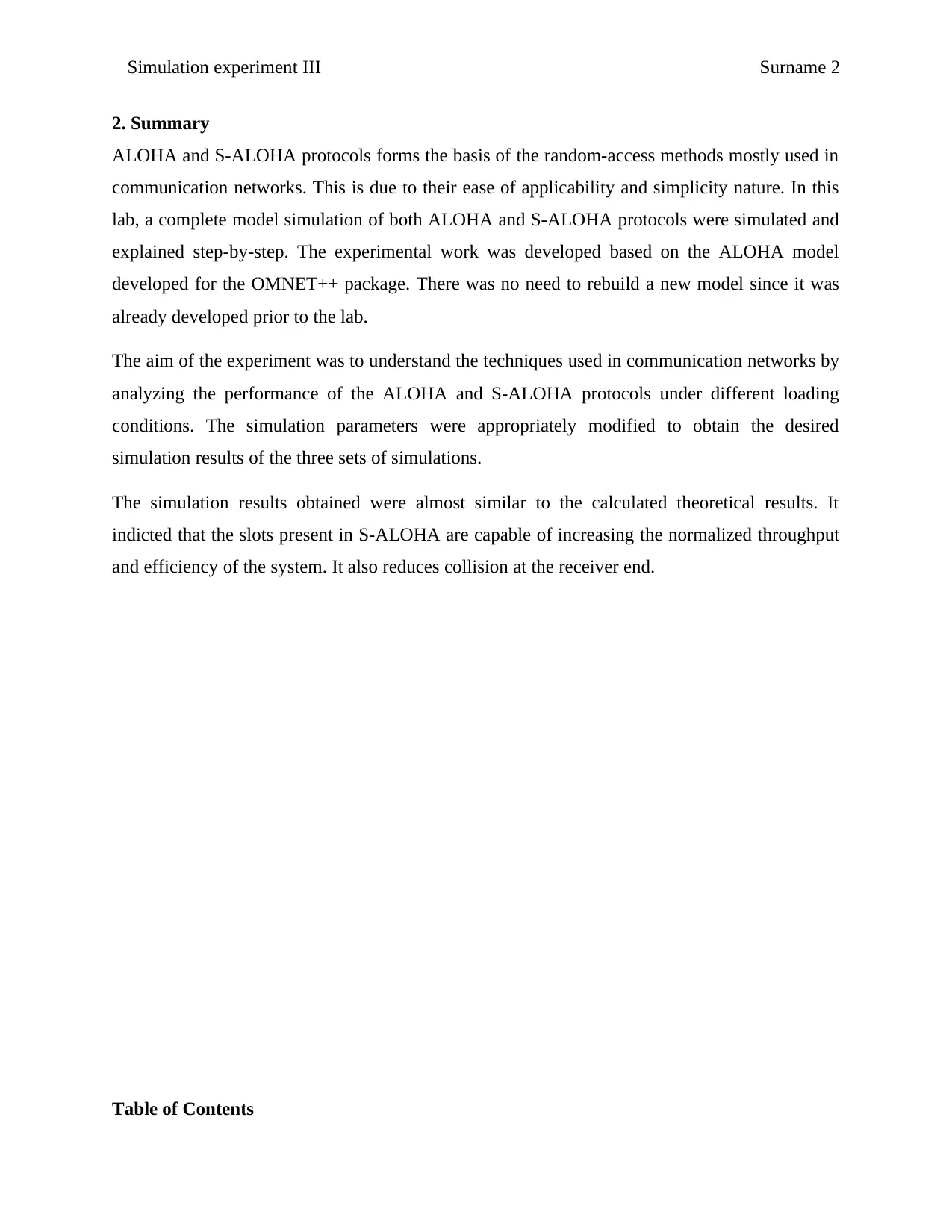
Simulation experiment III Surname 2
2. Summary
ALOHA and S-ALOHA protocols forms the basis of the random-access methods mostly used in
communication networks. This is due to their ease of applicability and simplicity nature. In this
lab, a complete model simulation of both ALOHA and S-ALOHA protocols were simulated and
explained step-by-step. The experimental work was developed based on the ALOHA model
developed for the OMNET++ package. There was no need to rebuild a new model since it was
already developed prior to the lab.
The aim of the experiment was to understand the techniques used in communication networks by
analyzing the performance of the ALOHA and S-ALOHA protocols under different loading
conditions. The simulation parameters were appropriately modified to obtain the desired
simulation results of the three sets of simulations.
The simulation results obtained were almost similar to the calculated theoretical results. It
indicted that the slots present in S-ALOHA are capable of increasing the normalized throughput
and efficiency of the system. It also reduces collision at the receiver end.
Table of Contents
2. Summary
ALOHA and S-ALOHA protocols forms the basis of the random-access methods mostly used in
communication networks. This is due to their ease of applicability and simplicity nature. In this
lab, a complete model simulation of both ALOHA and S-ALOHA protocols were simulated and
explained step-by-step. The experimental work was developed based on the ALOHA model
developed for the OMNET++ package. There was no need to rebuild a new model since it was
already developed prior to the lab.
The aim of the experiment was to understand the techniques used in communication networks by
analyzing the performance of the ALOHA and S-ALOHA protocols under different loading
conditions. The simulation parameters were appropriately modified to obtain the desired
simulation results of the three sets of simulations.
The simulation results obtained were almost similar to the calculated theoretical results. It
indicted that the slots present in S-ALOHA are capable of increasing the normalized throughput
and efficiency of the system. It also reduces collision at the receiver end.
Table of Contents
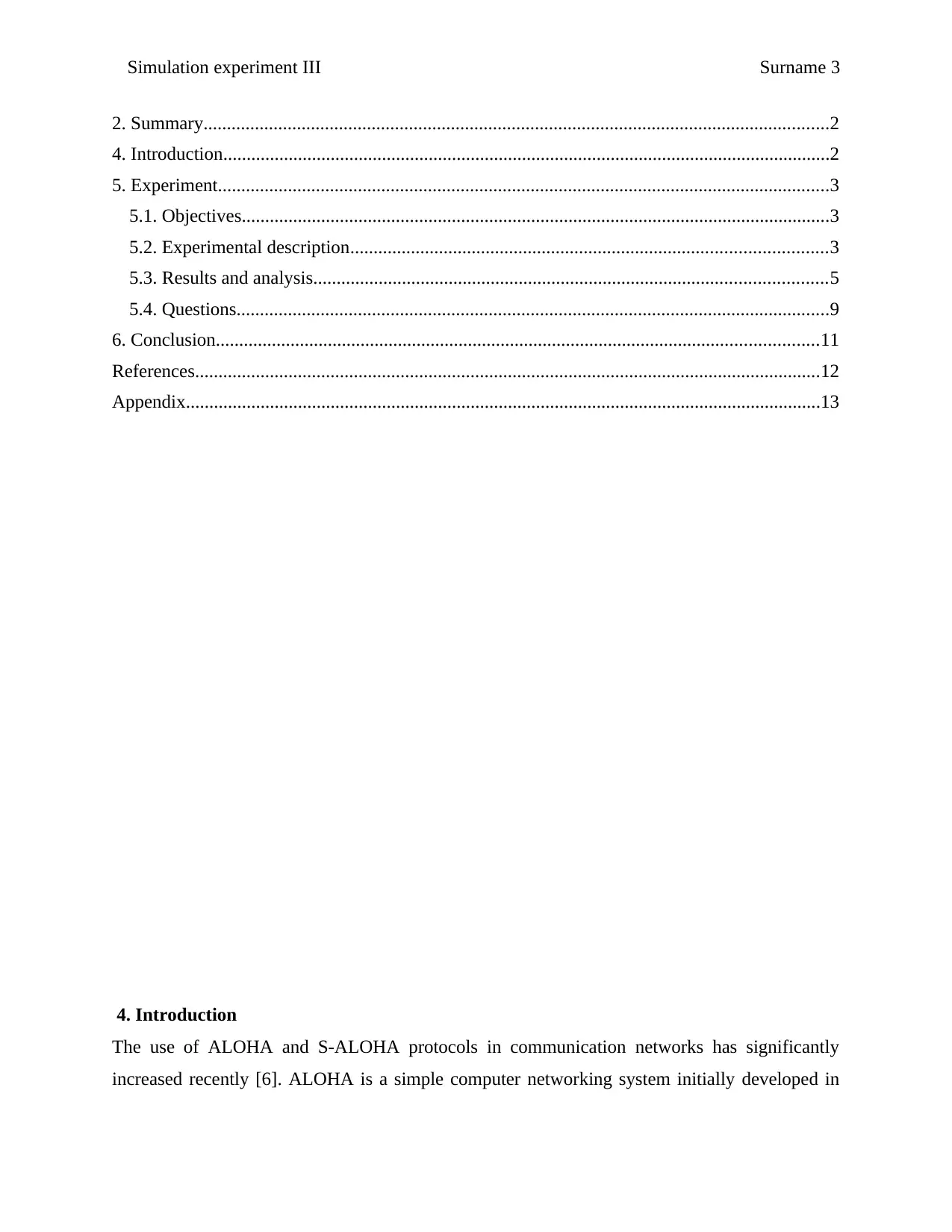
Simulation experiment III Surname 3
2. Summary......................................................................................................................................2
4. Introduction..................................................................................................................................2
5. Experiment...................................................................................................................................3
5.1. Objectives..............................................................................................................................3
5.2. Experimental description......................................................................................................3
5.3. Results and analysis..............................................................................................................5
5.4. Questions...............................................................................................................................9
6. Conclusion.................................................................................................................................11
References......................................................................................................................................12
Appendix........................................................................................................................................13
4. Introduction
The use of ALOHA and S-ALOHA protocols in communication networks has significantly
increased recently [6]. ALOHA is a simple computer networking system initially developed in
2. Summary......................................................................................................................................2
4. Introduction..................................................................................................................................2
5. Experiment...................................................................................................................................3
5.1. Objectives..............................................................................................................................3
5.2. Experimental description......................................................................................................3
5.3. Results and analysis..............................................................................................................5
5.4. Questions...............................................................................................................................9
6. Conclusion.................................................................................................................................11
References......................................................................................................................................12
Appendix........................................................................................................................................13
4. Introduction
The use of ALOHA and S-ALOHA protocols in communication networks has significantly
increased recently [6]. ALOHA is a simple computer networking system initially developed in
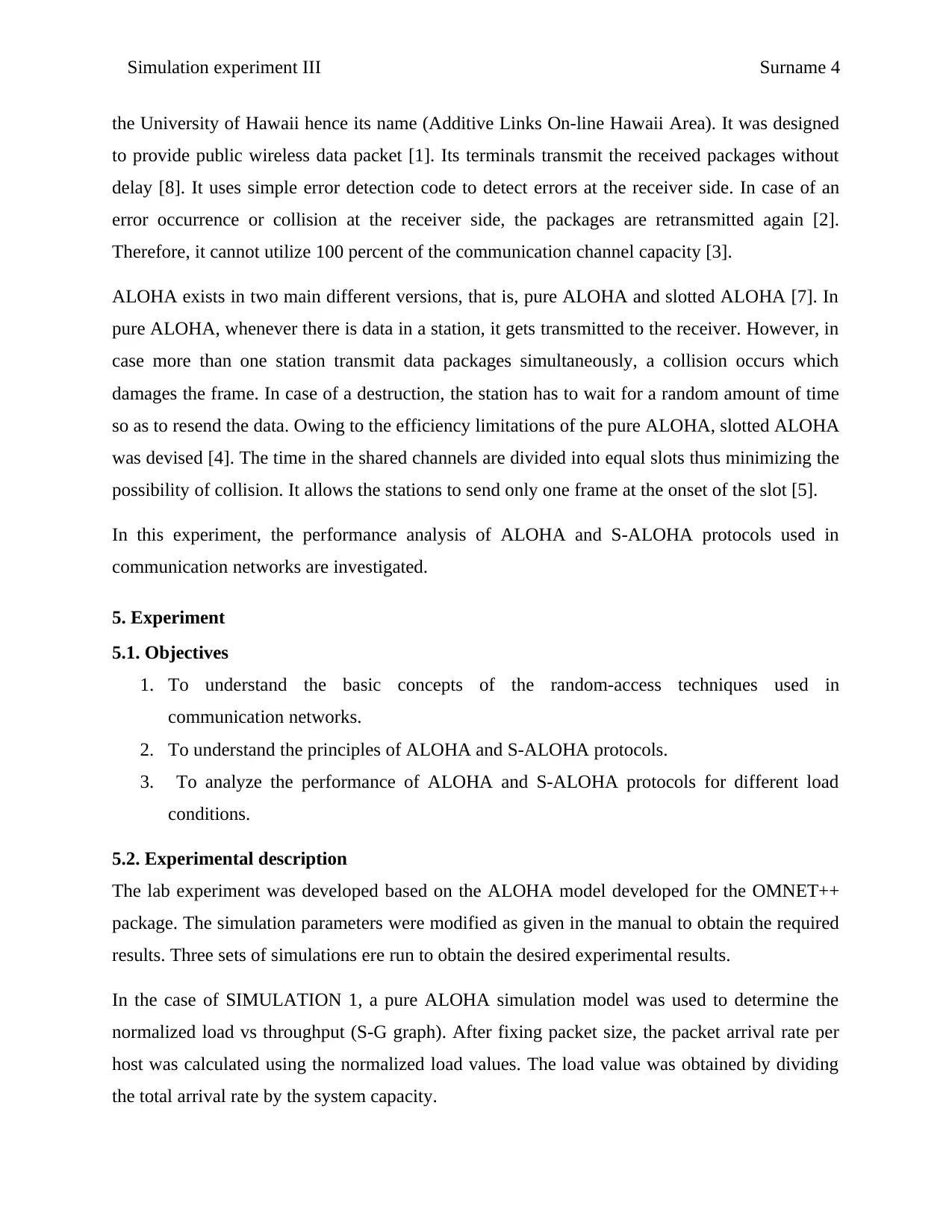
Simulation experiment III Surname 4
the University of Hawaii hence its name (Additive Links On-line Hawaii Area). It was designed
to provide public wireless data packet [1]. Its terminals transmit the received packages without
delay [8]. It uses simple error detection code to detect errors at the receiver side. In case of an
error occurrence or collision at the receiver side, the packages are retransmitted again [2].
Therefore, it cannot utilize 100 percent of the communication channel capacity [3].
ALOHA exists in two main different versions, that is, pure ALOHA and slotted ALOHA [7]. In
pure ALOHA, whenever there is data in a station, it gets transmitted to the receiver. However, in
case more than one station transmit data packages simultaneously, a collision occurs which
damages the frame. In case of a destruction, the station has to wait for a random amount of time
so as to resend the data. Owing to the efficiency limitations of the pure ALOHA, slotted ALOHA
was devised [4]. The time in the shared channels are divided into equal slots thus minimizing the
possibility of collision. It allows the stations to send only one frame at the onset of the slot [5].
In this experiment, the performance analysis of ALOHA and S-ALOHA protocols used in
communication networks are investigated.
5. Experiment
5.1. Objectives
1. To understand the basic concepts of the random-access techniques used in
communication networks.
2. To understand the principles of ALOHA and S-ALOHA protocols.
3. To analyze the performance of ALOHA and S-ALOHA protocols for different load
conditions.
5.2. Experimental description
The lab experiment was developed based on the ALOHA model developed for the OMNET++
package. The simulation parameters were modified as given in the manual to obtain the required
results. Three sets of simulations ere run to obtain the desired experimental results.
In the case of SIMULATION 1, a pure ALOHA simulation model was used to determine the
normalized load vs throughput (S-G graph). After fixing packet size, the packet arrival rate per
host was calculated using the normalized load values. The load value was obtained by dividing
the total arrival rate by the system capacity.
the University of Hawaii hence its name (Additive Links On-line Hawaii Area). It was designed
to provide public wireless data packet [1]. Its terminals transmit the received packages without
delay [8]. It uses simple error detection code to detect errors at the receiver side. In case of an
error occurrence or collision at the receiver side, the packages are retransmitted again [2].
Therefore, it cannot utilize 100 percent of the communication channel capacity [3].
ALOHA exists in two main different versions, that is, pure ALOHA and slotted ALOHA [7]. In
pure ALOHA, whenever there is data in a station, it gets transmitted to the receiver. However, in
case more than one station transmit data packages simultaneously, a collision occurs which
damages the frame. In case of a destruction, the station has to wait for a random amount of time
so as to resend the data. Owing to the efficiency limitations of the pure ALOHA, slotted ALOHA
was devised [4]. The time in the shared channels are divided into equal slots thus minimizing the
possibility of collision. It allows the stations to send only one frame at the onset of the slot [5].
In this experiment, the performance analysis of ALOHA and S-ALOHA protocols used in
communication networks are investigated.
5. Experiment
5.1. Objectives
1. To understand the basic concepts of the random-access techniques used in
communication networks.
2. To understand the principles of ALOHA and S-ALOHA protocols.
3. To analyze the performance of ALOHA and S-ALOHA protocols for different load
conditions.
5.2. Experimental description
The lab experiment was developed based on the ALOHA model developed for the OMNET++
package. The simulation parameters were modified as given in the manual to obtain the required
results. Three sets of simulations ere run to obtain the desired experimental results.
In the case of SIMULATION 1, a pure ALOHA simulation model was used to determine the
normalized load vs throughput (S-G graph). After fixing packet size, the packet arrival rate per
host was calculated using the normalized load values. The load value was obtained by dividing
the total arrival rate by the system capacity.
Secure Best Marks with AI Grader
Need help grading? Try our AI Grader for instant feedback on your assignments.

Simulation experiment III Surname 5
In SIMULATION II, pure ALOHA model was also used. The average packet size was assumed
to be 1912 bits while the pacer length distribution was change by the exponential distribution.
Two sets of results were obtained suing two different random numbers.
In SIMULATION III, S-ALOHA simulation model was used. The same parameters as in the
case of simulation I were used to obtained the desired experimental results. Frames in slotted and
pure ALOHA are shown in figure 1 and 2 (Sveum, 2000).
Figure 1: Frames in pure ALOHA
Figure 2: Frames in slotted ALOHA
5.3. Results and analysis
MATLAB was used to analyses and graphically represent the simulation results.
S/G (Normalized load vs normalized throughput) for the three simulation scenarios
In SIMULATION II, pure ALOHA model was also used. The average packet size was assumed
to be 1912 bits while the pacer length distribution was change by the exponential distribution.
Two sets of results were obtained suing two different random numbers.
In SIMULATION III, S-ALOHA simulation model was used. The same parameters as in the
case of simulation I were used to obtained the desired experimental results. Frames in slotted and
pure ALOHA are shown in figure 1 and 2 (Sveum, 2000).
Figure 1: Frames in pure ALOHA
Figure 2: Frames in slotted ALOHA
5.3. Results and analysis
MATLAB was used to analyses and graphically represent the simulation results.
S/G (Normalized load vs normalized throughput) for the three simulation scenarios
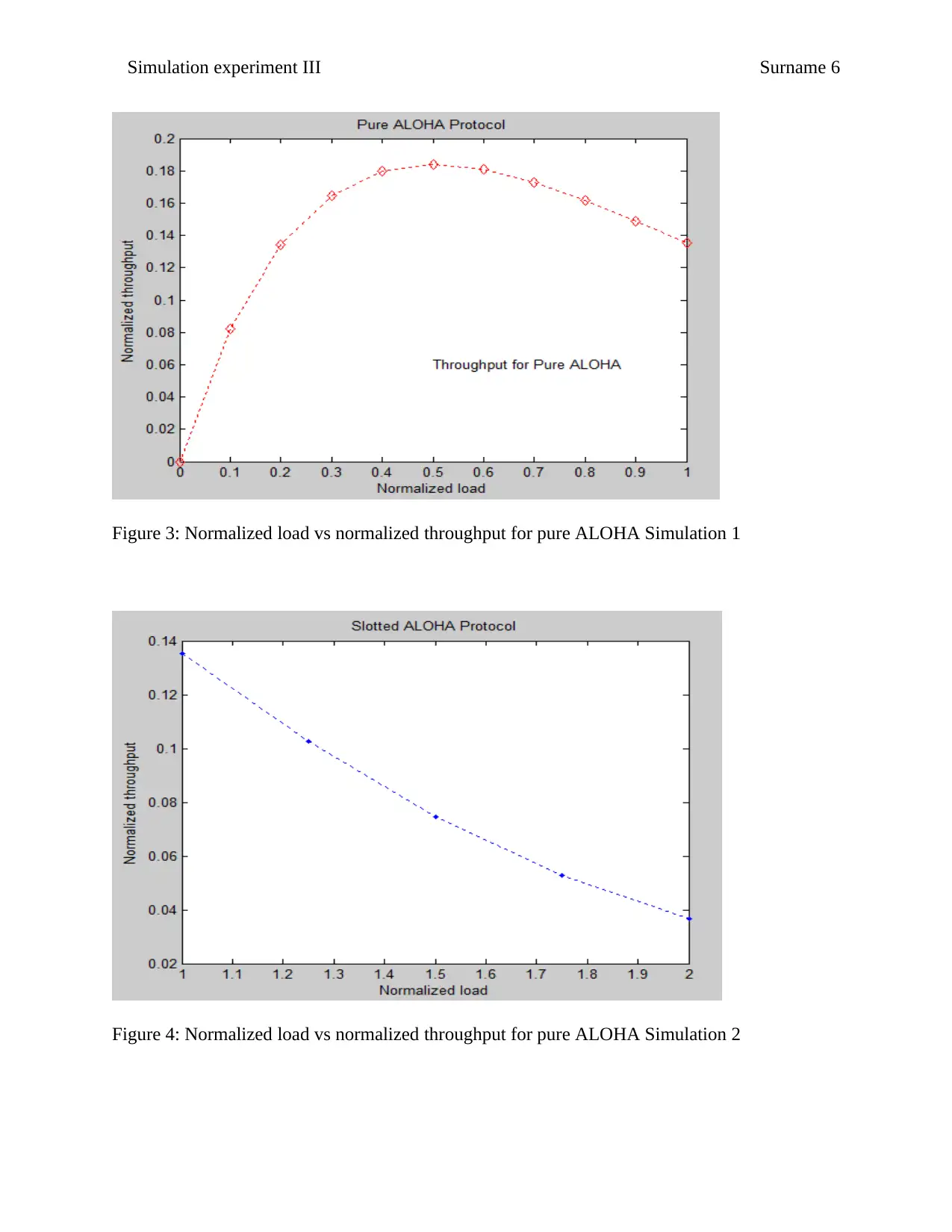
Simulation experiment III Surname 6
Figure 3: Normalized load vs normalized throughput for pure ALOHA Simulation 1
Figure 4: Normalized load vs normalized throughput for pure ALOHA Simulation 2
Figure 3: Normalized load vs normalized throughput for pure ALOHA Simulation 1
Figure 4: Normalized load vs normalized throughput for pure ALOHA Simulation 2
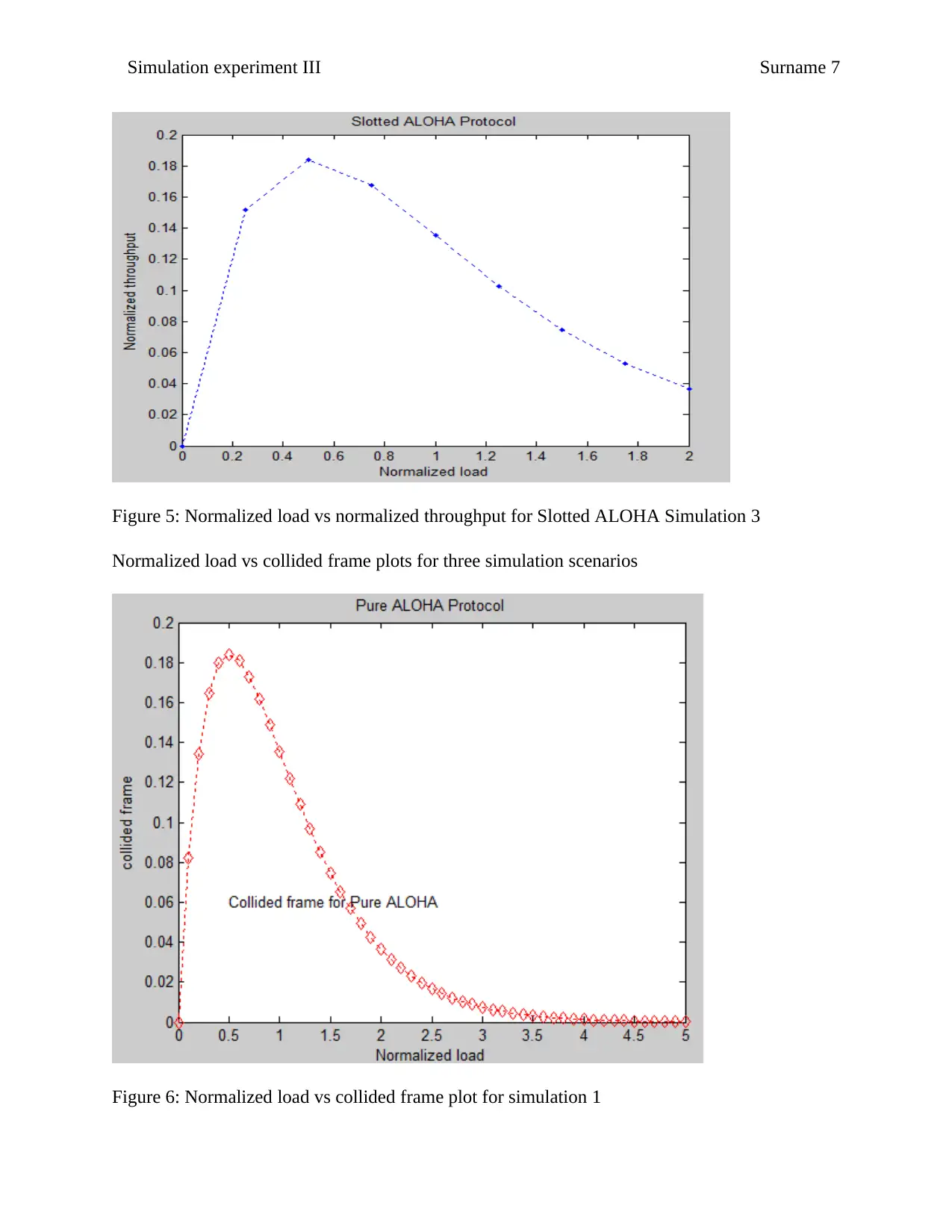
Simulation experiment III Surname 7
Figure 5: Normalized load vs normalized throughput for Slotted ALOHA Simulation 3
Normalized load vs collided frame plots for three simulation scenarios
Figure 6: Normalized load vs collided frame plot for simulation 1
Figure 5: Normalized load vs normalized throughput for Slotted ALOHA Simulation 3
Normalized load vs collided frame plots for three simulation scenarios
Figure 6: Normalized load vs collided frame plot for simulation 1
Paraphrase This Document
Need a fresh take? Get an instant paraphrase of this document with our AI Paraphraser

Simulation experiment III Surname 8
Figure 7: Normalized load vs collided frame plot for simulation 2
Figure 8: Normalized load vs collided frame plot for simulation 3
Figure 7: Normalized load vs collided frame plot for simulation 2
Figure 8: Normalized load vs collided frame plot for simulation 3
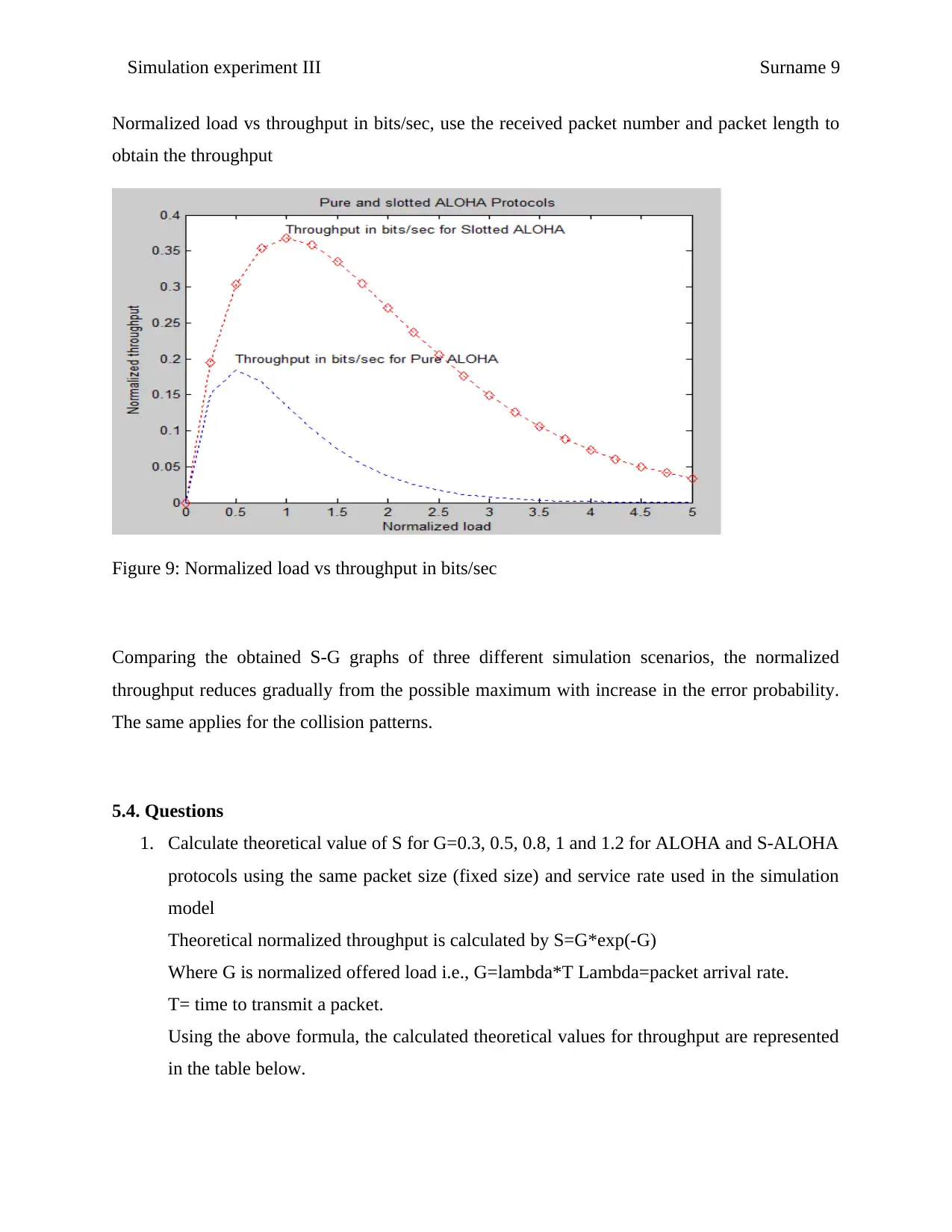
Simulation experiment III Surname 9
Normalized load vs throughput in bits/sec, use the received packet number and packet length to
obtain the throughput
Figure 9: Normalized load vs throughput in bits/sec
Comparing the obtained S-G graphs of three different simulation scenarios, the normalized
throughput reduces gradually from the possible maximum with increase in the error probability.
The same applies for the collision patterns.
5.4. Questions
1. Calculate theoretical value of S for G=0.3, 0.5, 0.8, 1 and 1.2 for ALOHA and S-ALOHA
protocols using the same packet size (fixed size) and service rate used in the simulation
model
Theoretical normalized throughput is calculated by S=G*exp(-G)
Where G is normalized offered load i.e., G=lambda*T Lambda=packet arrival rate.
T= time to transmit a packet.
Using the above formula, the calculated theoretical values for throughput are represented
in the table below.
Normalized load vs throughput in bits/sec, use the received packet number and packet length to
obtain the throughput
Figure 9: Normalized load vs throughput in bits/sec
Comparing the obtained S-G graphs of three different simulation scenarios, the normalized
throughput reduces gradually from the possible maximum with increase in the error probability.
The same applies for the collision patterns.
5.4. Questions
1. Calculate theoretical value of S for G=0.3, 0.5, 0.8, 1 and 1.2 for ALOHA and S-ALOHA
protocols using the same packet size (fixed size) and service rate used in the simulation
model
Theoretical normalized throughput is calculated by S=G*exp(-G)
Where G is normalized offered load i.e., G=lambda*T Lambda=packet arrival rate.
T= time to transmit a packet.
Using the above formula, the calculated theoretical values for throughput are represented
in the table below.
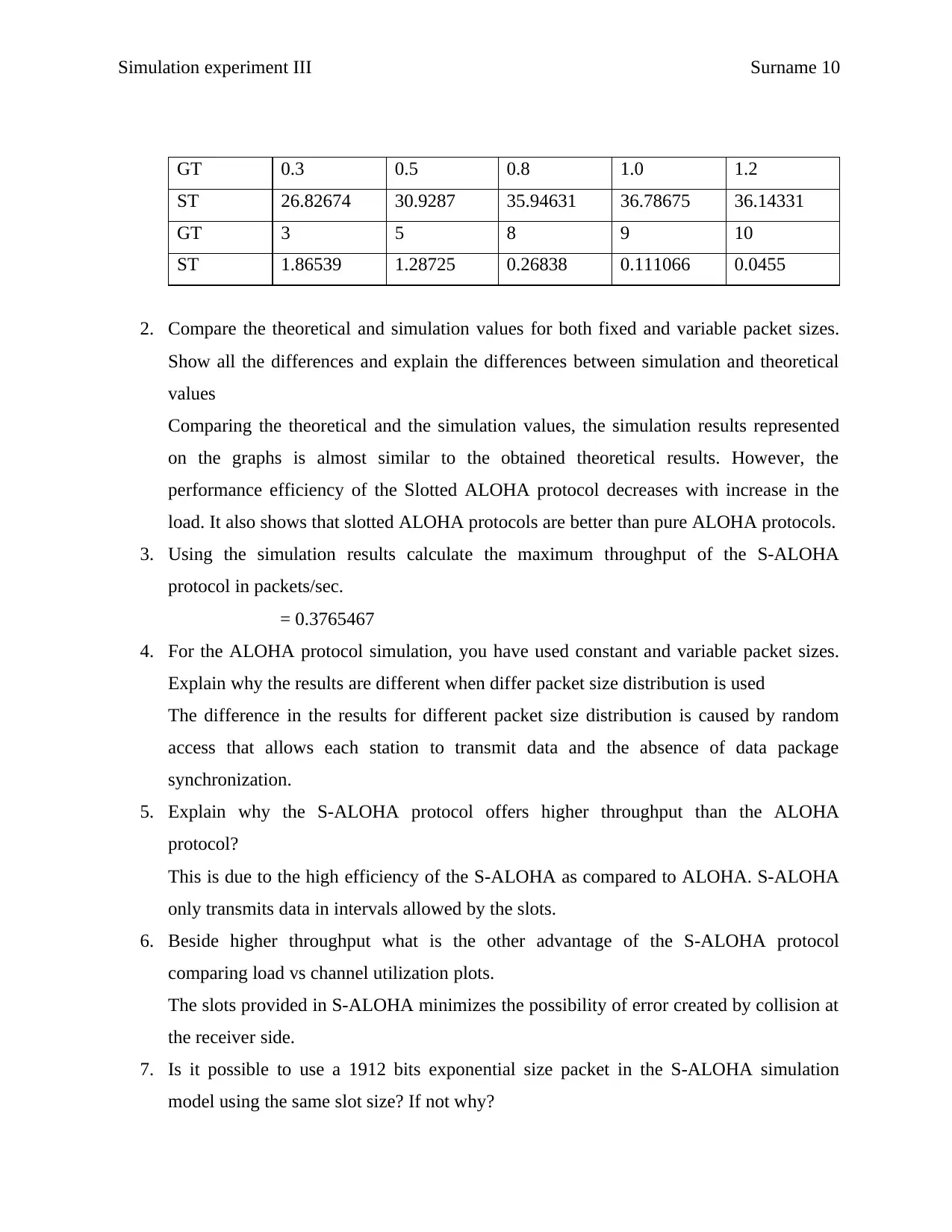
Simulation experiment III Surname 10
GT 0.3 0.5 0.8 1.0 1.2
ST 26.82674 30.9287 35.94631 36.78675 36.14331
GT 3 5 8 9 10
ST 1.86539 1.28725 0.26838 0.111066 0.0455
2. Compare the theoretical and simulation values for both fixed and variable packet sizes.
Show all the differences and explain the differences between simulation and theoretical
values
Comparing the theoretical and the simulation values, the simulation results represented
on the graphs is almost similar to the obtained theoretical results. However, the
performance efficiency of the Slotted ALOHA protocol decreases with increase in the
load. It also shows that slotted ALOHA protocols are better than pure ALOHA protocols.
3. Using the simulation results calculate the maximum throughput of the S-ALOHA
protocol in packets/sec.
= 0.3765467
4. For the ALOHA protocol simulation, you have used constant and variable packet sizes.
Explain why the results are different when differ packet size distribution is used
The difference in the results for different packet size distribution is caused by random
access that allows each station to transmit data and the absence of data package
synchronization.
5. Explain why the S-ALOHA protocol offers higher throughput than the ALOHA
protocol?
This is due to the high efficiency of the S-ALOHA as compared to ALOHA. S-ALOHA
only transmits data in intervals allowed by the slots.
6. Beside higher throughput what is the other advantage of the S-ALOHA protocol
comparing load vs channel utilization plots.
The slots provided in S-ALOHA minimizes the possibility of error created by collision at
the receiver side.
7. Is it possible to use a 1912 bits exponential size packet in the S-ALOHA simulation
model using the same slot size? If not why?
GT 0.3 0.5 0.8 1.0 1.2
ST 26.82674 30.9287 35.94631 36.78675 36.14331
GT 3 5 8 9 10
ST 1.86539 1.28725 0.26838 0.111066 0.0455
2. Compare the theoretical and simulation values for both fixed and variable packet sizes.
Show all the differences and explain the differences between simulation and theoretical
values
Comparing the theoretical and the simulation values, the simulation results represented
on the graphs is almost similar to the obtained theoretical results. However, the
performance efficiency of the Slotted ALOHA protocol decreases with increase in the
load. It also shows that slotted ALOHA protocols are better than pure ALOHA protocols.
3. Using the simulation results calculate the maximum throughput of the S-ALOHA
protocol in packets/sec.
= 0.3765467
4. For the ALOHA protocol simulation, you have used constant and variable packet sizes.
Explain why the results are different when differ packet size distribution is used
The difference in the results for different packet size distribution is caused by random
access that allows each station to transmit data and the absence of data package
synchronization.
5. Explain why the S-ALOHA protocol offers higher throughput than the ALOHA
protocol?
This is due to the high efficiency of the S-ALOHA as compared to ALOHA. S-ALOHA
only transmits data in intervals allowed by the slots.
6. Beside higher throughput what is the other advantage of the S-ALOHA protocol
comparing load vs channel utilization plots.
The slots provided in S-ALOHA minimizes the possibility of error created by collision at
the receiver side.
7. Is it possible to use a 1912 bits exponential size packet in the S-ALOHA simulation
model using the same slot size? If not why?
Secure Best Marks with AI Grader
Need help grading? Try our AI Grader for instant feedback on your assignments.
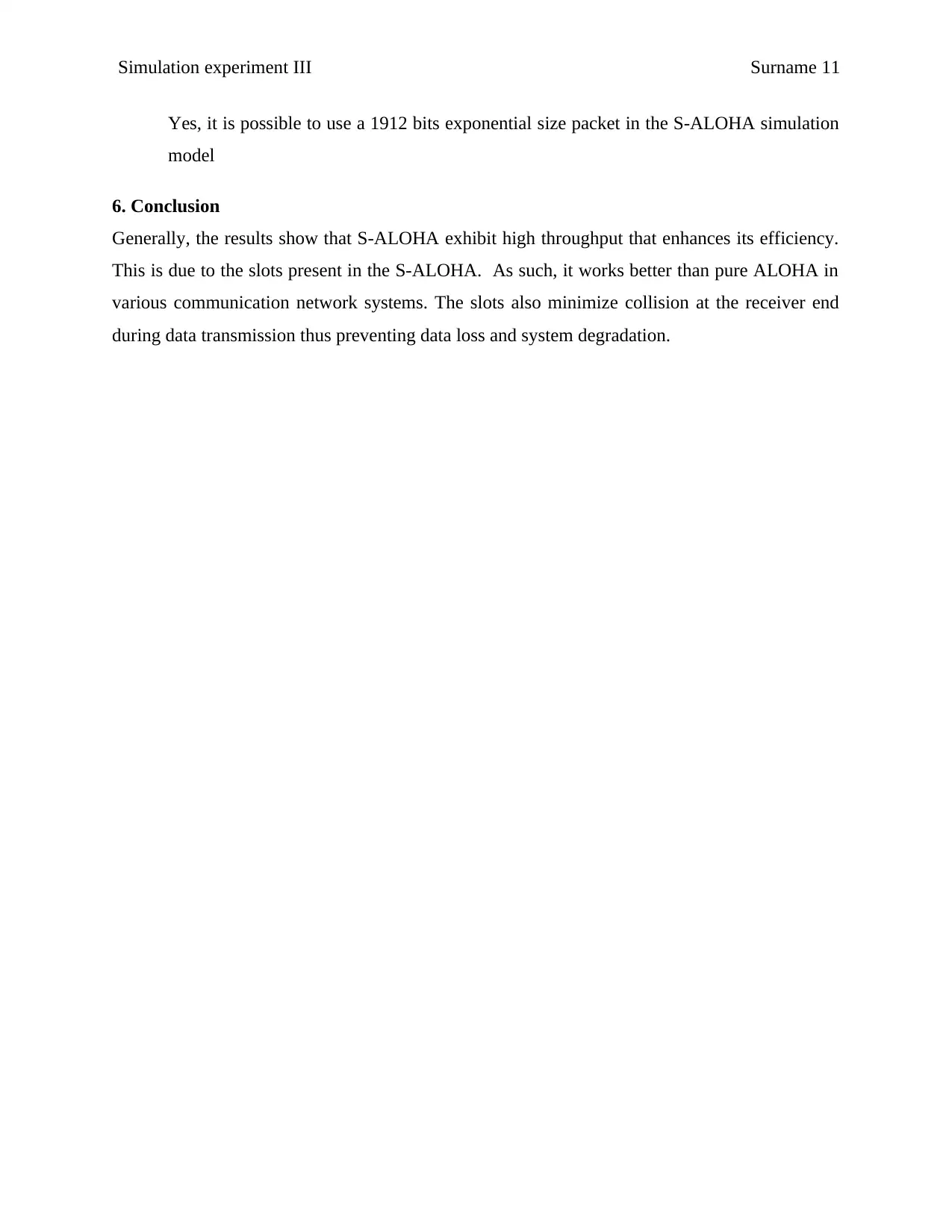
Simulation experiment III Surname 11
Yes, it is possible to use a 1912 bits exponential size packet in the S-ALOHA simulation
model
6. Conclusion
Generally, the results show that S-ALOHA exhibit high throughput that enhances its efficiency.
This is due to the slots present in the S-ALOHA. As such, it works better than pure ALOHA in
various communication network systems. The slots also minimize collision at the receiver end
during data transmission thus preventing data loss and system degradation.
Yes, it is possible to use a 1912 bits exponential size packet in the S-ALOHA simulation
model
6. Conclusion
Generally, the results show that S-ALOHA exhibit high throughput that enhances its efficiency.
This is due to the slots present in the S-ALOHA. As such, it works better than pure ALOHA in
various communication network systems. The slots also minimize collision at the receiver end
during data transmission thus preventing data loss and system degradation.
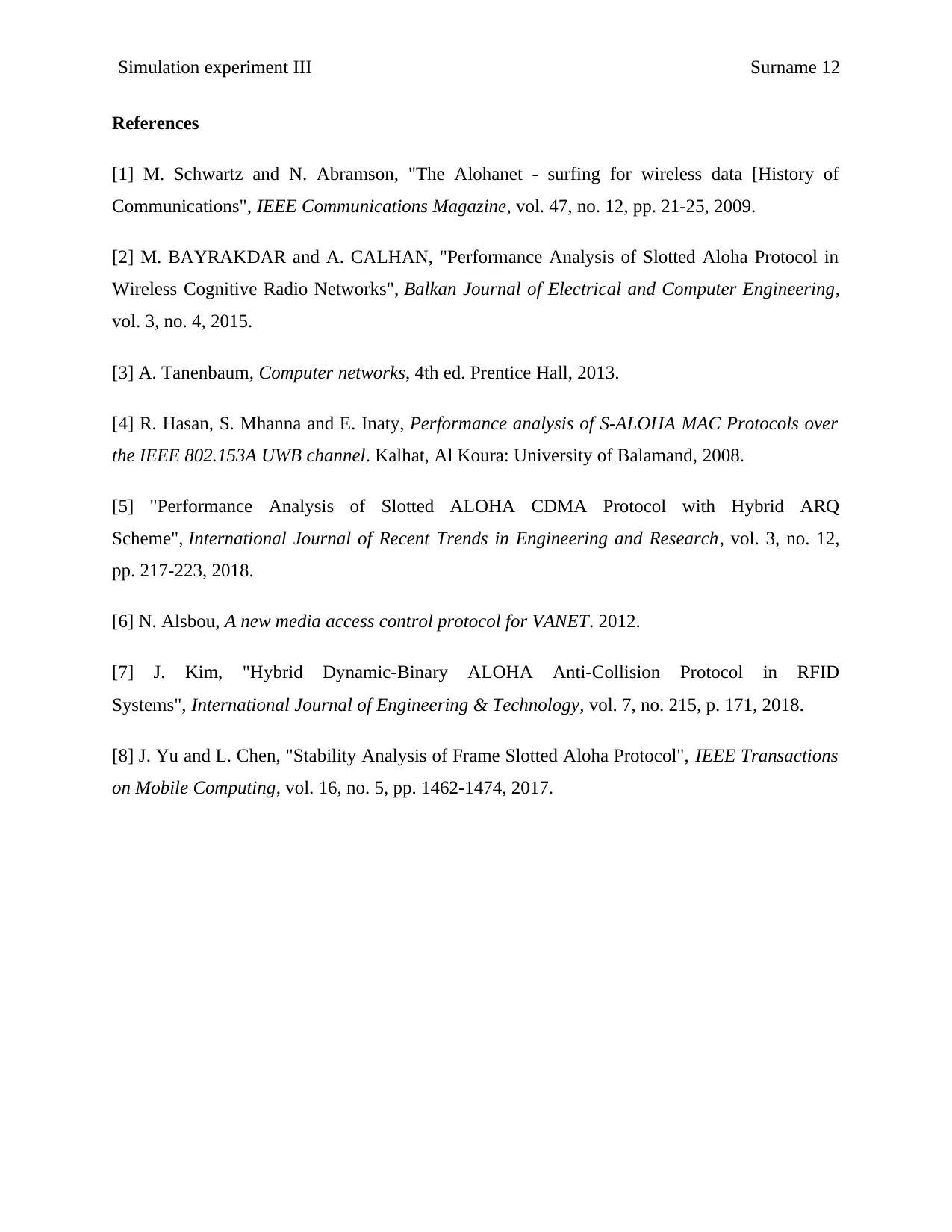
Simulation experiment III Surname 12
References
[1] M. Schwartz and N. Abramson, "The Alohanet - surfing for wireless data [History of
Communications", IEEE Communications Magazine, vol. 47, no. 12, pp. 21-25, 2009.
[2] M. BAYRAKDAR and A. CALHAN, "Performance Analysis of Slotted Aloha Protocol in
Wireless Cognitive Radio Networks", Balkan Journal of Electrical and Computer Engineering,
vol. 3, no. 4, 2015.
[3] A. Tanenbaum, Computer networks, 4th ed. Prentice Hall, 2013.
[4] R. Hasan, S. Mhanna and E. Inaty, Performance analysis of S-ALOHA MAC Protocols over
the IEEE 802.153A UWB channel. Kalhat, Al Koura: University of Balamand, 2008.
[5] "Performance Analysis of Slotted ALOHA CDMA Protocol with Hybrid ARQ
Scheme", International Journal of Recent Trends in Engineering and Research, vol. 3, no. 12,
pp. 217-223, 2018.
[6] N. Alsbou, A new media access control protocol for VANET. 2012.
[7] J. Kim, "Hybrid Dynamic-Binary ALOHA Anti-Collision Protocol in RFID
Systems", International Journal of Engineering & Technology, vol. 7, no. 215, p. 171, 2018.
[8] J. Yu and L. Chen, "Stability Analysis of Frame Slotted Aloha Protocol", IEEE Transactions
on Mobile Computing, vol. 16, no. 5, pp. 1462-1474, 2017.
References
[1] M. Schwartz and N. Abramson, "The Alohanet - surfing for wireless data [History of
Communications", IEEE Communications Magazine, vol. 47, no. 12, pp. 21-25, 2009.
[2] M. BAYRAKDAR and A. CALHAN, "Performance Analysis of Slotted Aloha Protocol in
Wireless Cognitive Radio Networks", Balkan Journal of Electrical and Computer Engineering,
vol. 3, no. 4, 2015.
[3] A. Tanenbaum, Computer networks, 4th ed. Prentice Hall, 2013.
[4] R. Hasan, S. Mhanna and E. Inaty, Performance analysis of S-ALOHA MAC Protocols over
the IEEE 802.153A UWB channel. Kalhat, Al Koura: University of Balamand, 2008.
[5] "Performance Analysis of Slotted ALOHA CDMA Protocol with Hybrid ARQ
Scheme", International Journal of Recent Trends in Engineering and Research, vol. 3, no. 12,
pp. 217-223, 2018.
[6] N. Alsbou, A new media access control protocol for VANET. 2012.
[7] J. Kim, "Hybrid Dynamic-Binary ALOHA Anti-Collision Protocol in RFID
Systems", International Journal of Engineering & Technology, vol. 7, no. 215, p. 171, 2018.
[8] J. Yu and L. Chen, "Stability Analysis of Frame Slotted Aloha Protocol", IEEE Transactions
on Mobile Computing, vol. 16, no. 5, pp. 1462-1474, 2017.

Simulation experiment III Surname 13
Appendix
a) MATLAB code for the normalized load vs normalized throughput for pure ALOHA
%S/G (Normalized load vs normalized throughput) for pure ALOHA
G=0:0.1:1;
S=G.*exp(-2*G);
plot(G,S,'rd:');
title ('Pure ALOHA Protocol');
xlabel ('Normalized load');
ylabel ('Normalized throughput');
text (0.5,.06,'Throughput for Pure ALOHA');
legend ('Pure ALOHA','Location','NorthEastInside');
b) MATLAB code for the normalized load vs normalized throughput for Slotted ALOHA
%S/G (Normalized load vs normalized throughput) for Slotted ALOHA
G=1:0.25:2;
S=G.*exp(-2*G);
Plot (G,S,'b.:');
Title ('Slotted ALOHA Protocol');
xlabel ('Normalized load');
ylabel ('Normalized throughput');
text (0.5,.6,'Throughput for SLOTTED ALOHA');
legend ('Slotted ALOHA','Location','NorthEastInside');
c) MATLAB code for normalized load vs throughput in bits/sec
%Normalized load vs normalized throughput in bits/sec for pure and slotted ALOHA
G=0:0.25:5;
S=G.*exp(-G);
Appendix
a) MATLAB code for the normalized load vs normalized throughput for pure ALOHA
%S/G (Normalized load vs normalized throughput) for pure ALOHA
G=0:0.1:1;
S=G.*exp(-2*G);
plot(G,S,'rd:');
title ('Pure ALOHA Protocol');
xlabel ('Normalized load');
ylabel ('Normalized throughput');
text (0.5,.06,'Throughput for Pure ALOHA');
legend ('Pure ALOHA','Location','NorthEastInside');
b) MATLAB code for the normalized load vs normalized throughput for Slotted ALOHA
%S/G (Normalized load vs normalized throughput) for Slotted ALOHA
G=1:0.25:2;
S=G.*exp(-2*G);
Plot (G,S,'b.:');
Title ('Slotted ALOHA Protocol');
xlabel ('Normalized load');
ylabel ('Normalized throughput');
text (0.5,.6,'Throughput for SLOTTED ALOHA');
legend ('Slotted ALOHA','Location','NorthEastInside');
c) MATLAB code for normalized load vs throughput in bits/sec
%Normalized load vs normalized throughput in bits/sec for pure and slotted ALOHA
G=0:0.25:5;
S=G.*exp(-G);
Paraphrase This Document
Need a fresh take? Get an instant paraphrase of this document with our AI Paraphraser

Simulation experiment III Surname 14
plot(G,S,'rd:');
title ('Pure and slotted ALOHA Protocols');
xlabel ('Normalized load');
ylabel ('Normalized throughput');
text (1,.38,'Throughput in bits/sec for Slotted ALOHA');
hold on;
S1=G.*exp(-2*G);
plot (G,S1,'b:');
text (0.5,.2,'Throughput in bits/sec for Pure ALOHA');
legend ('Slotted ALOHA','Pure ALOHA','Location','NorthEastInside');
plot(G,S,'rd:');
title ('Pure and slotted ALOHA Protocols');
xlabel ('Normalized load');
ylabel ('Normalized throughput');
text (1,.38,'Throughput in bits/sec for Slotted ALOHA');
hold on;
S1=G.*exp(-2*G);
plot (G,S1,'b:');
text (0.5,.2,'Throughput in bits/sec for Pure ALOHA');
legend ('Slotted ALOHA','Pure ALOHA','Location','NorthEastInside');
1 out of 14
Your All-in-One AI-Powered Toolkit for Academic Success.
+13062052269
info@desklib.com
Available 24*7 on WhatsApp / Email
![[object Object]](/_next/static/media/star-bottom.7253800d.svg)
Unlock your academic potential
© 2024 | Zucol Services PVT LTD | All rights reserved.

